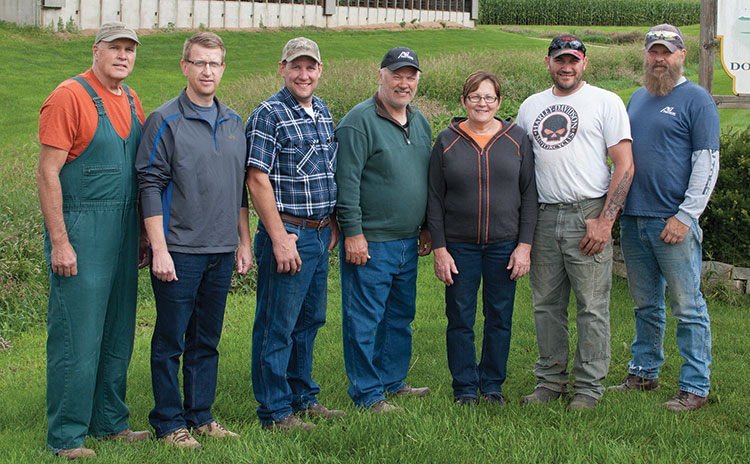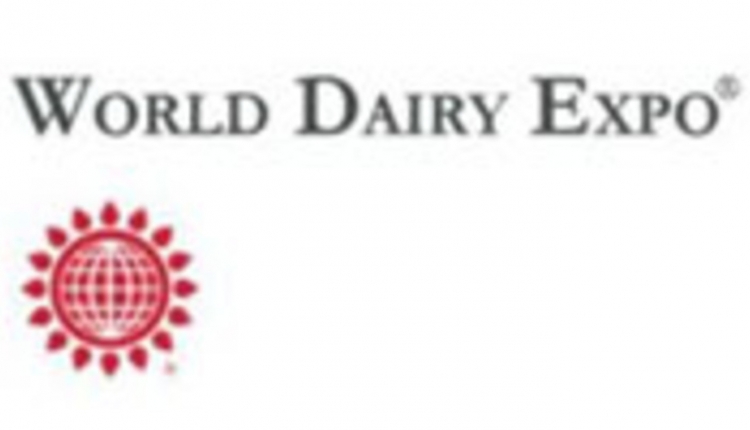
This year's 10th annual Dairy Cattle Reproduction Council Award's competition drew the second largest set of nominations to date from 16 U.S. states, Canada, and Italy. From that pool of nominees, judges reviewed farm statistics and selected 33 herds for a more in-depth examination.
In the final phase of judging, a combination of statistical analysis and thorough inspection by the judging panel narrowed the field down to the top 24 herds. Throughout the entire process, judges only viewed each farm’s data and did not actually learn of herd or nominator names until the final tabulations were completed by the awards committee chair. Following the judging process, a Hoard’s Dairyman editorial team member assisted the Dairy Cattle Reproduction Council by personally visiting each of the Platinum-winning herds during a one-week window.
It is safe to say, far more went into the judging process than simply evaluating pregnancy rates (PR). However, since readers are interested in statistical measurements, the Platinum herds had pregnancy rates averaging over 40 percent, and all of the Gold, Silver, and Bronze herds (listed on page 697) were above 30 percent PR. That’s a far cry from a decade ago when pregnancy rates in the high 20s would have earned Platinum honors.
Describe your synchronization program.

Emerald Spring: All cows receive a double ovsynch protocol for first breeding. Cows diagnosed open at pregnancy check will be enrolled in ovsynch that day with GnRH, or have a CIDR implanted if they are non-cycling. We also administer two prostaglandin for all ovsynch cows, 24 hours apart, three days prior to breeding.
We started double ovsynch on all first breedings in March 2016. That has really improved our first-service conception rate. Prior to that, we were using a presynch program of two prostaglandin shots and breeding any cows in heat that were past 50 DIM (days in milk).
Jer-Z-Boyz: Heats are observed and recorded after 30 DIM. The volunteer waiting period (VMP) is 50 days. We administer prostaglandin (Lutalyse) at 38 and 48 DIM and any cow not bred by 60 DIM is enrolled on ovsynch. We use visual inspection and tail chalk using an AM-PM breeding philosophy.
Plymouth: We use a modified 11-day presynch/72-hour co-synch. At our weekly pregnancy check, a veterinarian checks animals 29 to 35 days since last service. At that time, if open with a CL (corpus luteum), the cow is enrolled in the co-synch protocol. If the animal is open with no CL, the cow is enrolled in the co-synch protocol with a CIDR.
All animals open over 150 DIM are enrolled with a 48-hour co-synch protocol with a CIDR and reinseminated at 72 hours (or double bred). This has worked very well for us because of the protocol compliance by all involved. You can have all kinds of protocols, but the only way you can make good decisions about the results is if you know that the compliance of the protocol is being followed by people.
Rollin Green: We utilize the double ovsynch protocol for the first service on every cow. If a natural heat is missed and a cow comes up open on Day 32 post A.I., vet check day, we will start the ovsynch protocol a second time. If a cow still isn’t pregnant after two services, we start to CIDR synch as well. Beef semen is used by the fourth service.
Changes have been made in the last few years to help our pregnancy rate climb substantially: A.I. retraining, 21-day interval cows are painted, cows are walked three times a day, the VWP was backed off to 77 days, and two prostaglandin shots are given during ovsynch protocol.
As far as the heifers, they are given prostaglandin, and then if no heat is observed, they receive a second prostaglandin 14 days later. They always receive an Estrotect sticker with each prostaglandin and before 21 days postbreeding. Tail paint doesn’t seem to work with heifers for us, they won’t leave it alone. Heifers are in the A.I. breeding pen for a month and are then moved with the bull.
Schilling: Heifers are entered in the breeding pen at 13 months of age and bred based on visual inspection of Estrotect patched by the Genex team. Once moved into the breeding pen, most heifers are allowed to go through one estrous cycle before being bred at 13 months of age. Heifers get an ultrasound exam at 28 days postinsemination, and if found open with a CL, are given prostaglandin.
For first service, lactating cows are all bred on an ovsynch 48-hour program. All cows started on ovsynch at 77 DIM. GnRH1 (Cystorelin) (4 cc) is given Tuesday morning, prostaglandin1 (Lutalyse) (5 cc) is given seven days later on Tuesday morning, prostaglandin2 (5 cc) is given 24 hours later on Wednesday morning, and GnRH2 (2 cc) is given 48 hours after the first prostaglandin2 on Thursday morning. Breeding is done Thursday morning 8 hours after GnRH2.
Open cows are resynched with a similar program at herd health check. If a CL is present, ovsynch is started. If a CL is not present, 4 cc GnRH is given and ovsynch is initiated seven days later.
With these methods, our overall pregnancy rate is 38 percent with an overall 56 percent conception rate. Approximately 56 percent of our breedings are synchronized with a 62 percent conception rate. Ten percent of cows are classified as standing heat with a 49 percent conception rate while 33 percent are classified as chalk breedings with a 48 percent conception rate.
Weisenbeck: We use double ovsynch with a second prostaglandin right before breeding. We have been doing this for two years; this approach raised our pregnancy rate by 10 percent.
Do you use sexed semen?
Emerald Spring: We do not use sexed semen. We have excess heifers as it is now and don’t feel the need to raise more heifer calves. We do use beef semen on roughly 25 percent of our cow breedings to limit the number of dairy replacements.
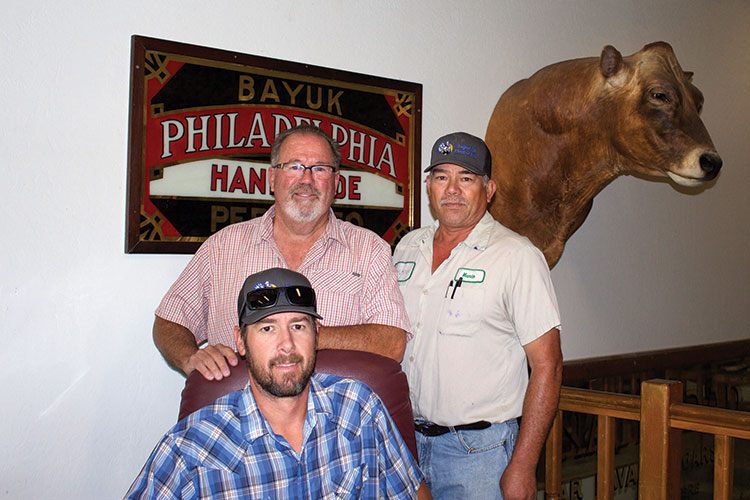
Jer-Z-Boyz: We use sex-sorted semen on both cows and heifers for three services, before using conventional beef semen.
Plymouth: Yes, we use sexed semen in heifers and first-lactation cows. On heifers, the first and second services are made to sexed semen with third and fourth services conventional semen. Over the last year, our percent conception with sexed semen is 55 percent on heifers and conventional semen is 62 percent. Overall, 52 percent of our services are to sexed semen on heifers. Over the last six months on heifers, our percent conception with sexed semen is 52 percent and conventional semen is 59 percent, with 63 percent of our breedings being sexed.
We started to breed our first-lactation animals with sexed semen this April. Since then, our conception with sexed semen on first-lactation animals is 42 percent versus 48 percent with conventional semen, with 52 percent of our breedings being sexed semen. In the last month, after seeing the results from the sexed semen in first-lactation animals, we have decided to breed all fourth-plus-lactation animals to beef semen.
Rollin Green: We haven’t used sexed semen for the last seven years. We stopped using the product once we filled our freestall barn with homegrown replacements. We finish out our steers and see value in both Holstein bull calves and beef cross calves for our feedlot.
Schilling: We use 90 percent sexed female semen on virgin heifers for the first two services. For services third and greater, we use conventional semen. Heifers will be marked do not breed if they do not settle by the fourth service. Conception rate of sexed semen in the heifers is 55 percent, and conventional semen is 64 percent. Sexed semen is not used in cows but we are considering it.
We have continued to use sexed semen on heifers as we feel that our 2-year-olds calve in with fewer difficulties thanks to the smaller calf size of the newborn heifer calves. We also have marketed excess heifers as an additional source of income for our dairy.
Weisenbeck: We currently use sexed semen on heifers on the first service and conventional on cows. We just prefer to get a female calf out of first-lactation heifers for ease of calving.
What positive changes have you made to your breeding program?
Emerald Spring: In March 2016, we moved into a new cross-ventilated barn. This allowed us to reduce our stocking rate from over 125 percent to 110 percent (on freestalls). Our older pens were all three-row and the new barn is two-row, so we were able to improve bunk space and number of headlocks in our early lactation/breeding pens.
All pens have feedline sprinklers. It was a significant investment, but after 18 months, we are very happy with how the cows have been performing.
Jer-Z-Boyz: Milk cows have been in self-lock stanchions, rubber mats, soakers, and shade cloth for over 25 years. Soakers and additional shade cloth for heifer A.I. is a consideration, especially after this past unusually hot summer in California.
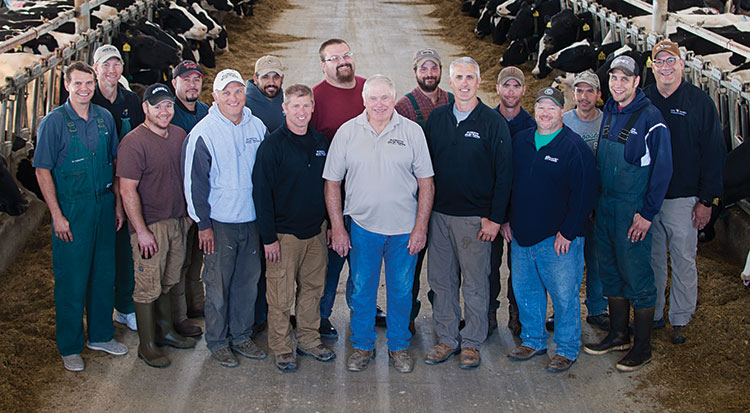
Plymouth: Over the years, we have continued to add more fans in the milk cow pens and recently added more fans in the parlor. During March through November, we put emphasis on maintaining our fans and sprinklers for heat abatement, along with power washing fans to keep them clean and moving the most air possible.
We continue to look at ways to improve heat abatement in our dry cow facility but haven’t completely figured that out since they are housed in an open lot with a monoslope building located on top of a hill. Any fans in the monoslope are going to compete with the natural breeze going through it.
Rollin Green: We built our barn in 2011, and it has resulted in massive improvements in overall cow comfort, health, and heat abatement. Production went up and health costs down. Sand bedding helps with traction for observing heats. Conception rates slip a few points in July and August but not anywhere near as bad as in previous years.
In the future, we are considering more fans over the feed alley and maybe sprinklers. For the heifers, we improved our handling of them by installing self-locks instead of a chute. The heifers have always been on a gravel lot.
Schilling: We feel cow cooling is critical to maintain conception rates during the summer. Changes we have made the last several years to improve cow cooling include adding three rows of fans per pen located over each row of free stalls, feed line water sprinklers, and additional water sprinklers in the holding area. In 2014, additional fans were added over cross alleys.
Dry cow cooling is also a focus with fans over the freestalls. Shade cloth has been added for the dry cow outside feeding to help keep them cool. We feel that the improved cooling of our dry cows has helped produce healthier follicles, which has led to higher first-service conception rates.
A third well was added recently to help maintain water pressure demand for the sprinklers and waterers. We feel the exceptional cow comfort from sand bedding with adequately sized freestalls has also been critical to minimize lameness and allow maximal heat expression.
Weisenbeck: The floors are grooved periodically for traction because the automatic scraper runs every two hours for a nice, clean surface. The naturally vented freestall barn is equipped with fans and sprinklers while the cross ventilated barn does not, but all cows get a good soaking in the parlor holding area. Flies are nonexistent in this barn as well.
What are changes you might implement to improve reproduction?
Emerald Spring: Improving our transition facilities is the next step for us.
Jer-Z-Boyz: We are looking at ways to adjust our feeding routine and milking schedule to minimize time on concrete. That would give our cows more free time to express their full genetic potential.
Speaking of genetic potential, we have paid closer attention to DPR (daughter pregnancy rate) when selecting service sires. It didn’t take long to recognize trends in our cow families and now it is taken into consideration when selecting cows to perform embryo transfer or in vitro fertilization.
Plymouth: We continue to monitor our protocols and results with our repro program team along with trusted advisers. With this group, we continue to look at ways to improve or tweak our program and stay educated about new tools or technologies available and decide if they would fit our program.
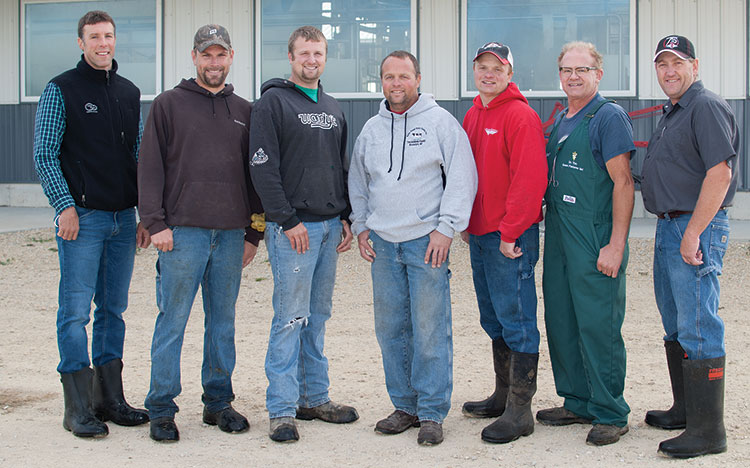
Rollin Green: In the future, it would be nice to implement modern heifer facilities to conduct pregnancy checks for heifers. We would like to improve housing to enhance growth rates and maybe lower the age at first calving. At some point, it would be beneficial to have some sort of heat detection software for the heifers to aid in heat detection. The heat detection in the milking herd is pretty solid, but there is definitely room for improvement for heat detection in the heifer pen.
Schilling: Two things we implemented after attending the last Dairy Cattle Reproduction Council (DCRC) meeting and listening to University of Wisconsin-Madison’s Paul Fricke include:
- Raising our first dose of GnRH in our ovsynch protocol from 2 cc to 4 cc
- Giving an additional 5 cc of prostaglandin in 24 hours after our first prostaglandin in our ovsynch protocol
As our herd production level has continued to improve and as our stocking density has grown, we feel those two technologies have helped us maintain and possibly improve our conception rates. We also have seen positive improvements from raising our VWP.
Another technology we have used since 2011 is genomic data on our cattle. We have created a custom index for our herd, including both production, longevity, and reproduction. We use genomic data to cull the bottom 15 percent of our heifers at 3 months of age. This has helped alleviate overcrowding in our heifer pens, as well as improve the genomic value of our cattle for reproduction.
Over the last decade, after selecting bulls for production, an emphasis has been put on using bulls with high daughter pregnancy rates as well as sire conception rate. This has resulted in improved genomic values for the herd’s reproduction. We feel through the use of genomic data, along with the proper environment, we have seen improvements in our conception and pregnancy rates in our herd.
Weisenbeck: Our herd’s reproduction has been improving consistently for the last 11 years with just making small tweaks to our program. We will continue that approach and see how far it will take us.
What advice do you have for others?
Emerald Spring: Don’t skimp when building new cow housing facilities. Cows need space. It’s hard to get cows pregnant when they are overcrowded. The use of a more aggressive synchronization program has also been successful for us.
Jer-Z-Boyz: Jerseys, nutrition, cow comfort, and a passion for doing everything right.
Plymouth: Focus on the main things that have a huge impact: 1. People; 2. Cow comfort; 3. Vaccination program; 4. Nutrition; 5. Protocol compliance; and 6. Transition period.
Keep it simple, monitor, and pay attention to details. Above all, focus on the people who have an impact on it all. These people include those who milk the cows, raise your heifers, manage your stall bedding, feed, maintain your equipment, work in the maternity area, take care of the cows (herdsmen), breed your animals, the nutritionist, and the veterinarian. Our success is because of their hard work.
Rollin Green: We were struggling with reproduction a few short years ago. The majority of the problem was my A.I. technique, and I am now a firm believer in getting A.I. retrained every few years.
However, in the process of struggling through the problems we were having, we made substantial improvements to our program by seeking out advice. We rewrote our farm’s protocols to get cows pregnant. The few changes we made a few years ago as discussed earlier included: A.I. retraining, walk cows three times a day watching 21-day interval cows, implement two prostaglandins to ovsynch, make sure every protocol is followed correctly, and raise our VWP. On our dairy, a million things have to go right for everything to go smoothly, but it only takes one thing to go wrong to wreck it all.
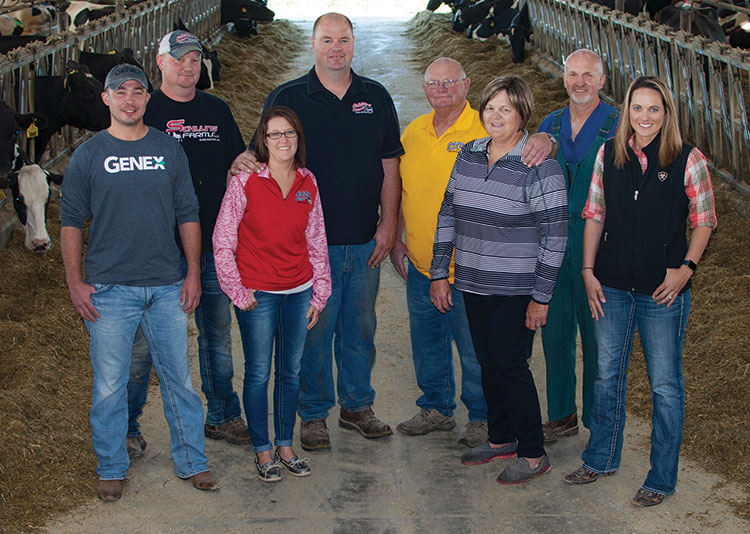
Schilling: We feel cow comfort, foot health, cooling, nutrition, and fresh cow care are essential for a successful reproductive program. All factors depend on each other for a successful breeding system. In addition, having set protocols and routines for synching and resynching have helped maintain excellent compliance essential to reproductive success.
Also, find breeding companies that you feel comfortable with and that will spend adequate time monitoring the cows for heat. We feel our Genex team is excellent and very good at heat detection. Ultrasound has also allowed us to more accurately manage our breeding program.
Weisenbeck: Everyone has to realize what works for one farm may not work for another. People and management make you successful in this industry, and to just give your herd the best chance to thrive is the best advice we can give.
